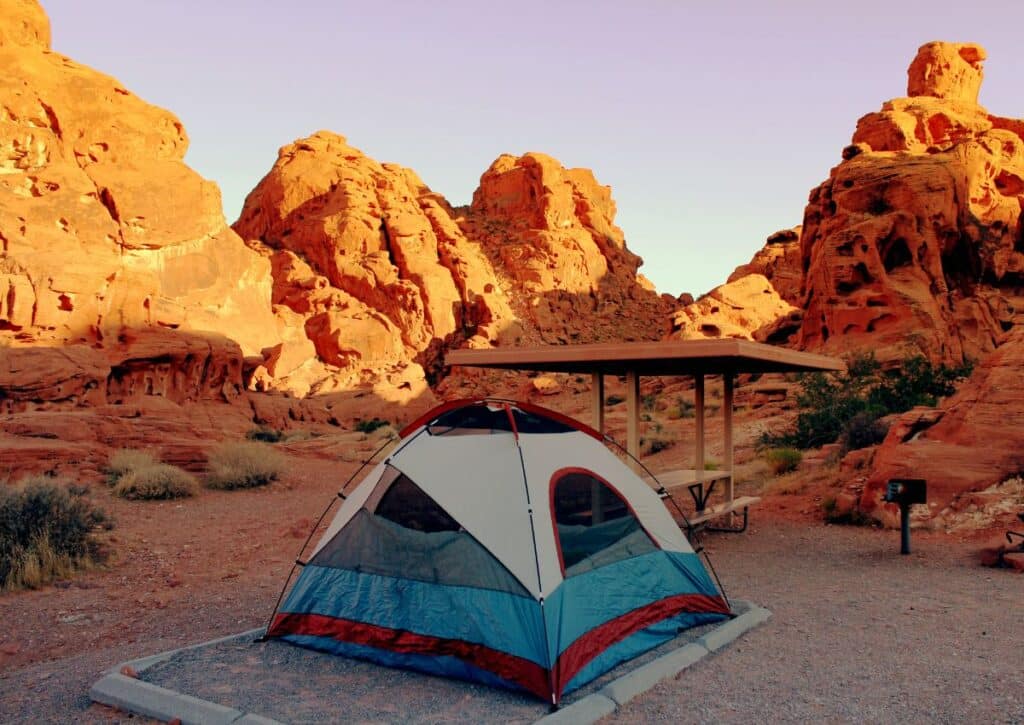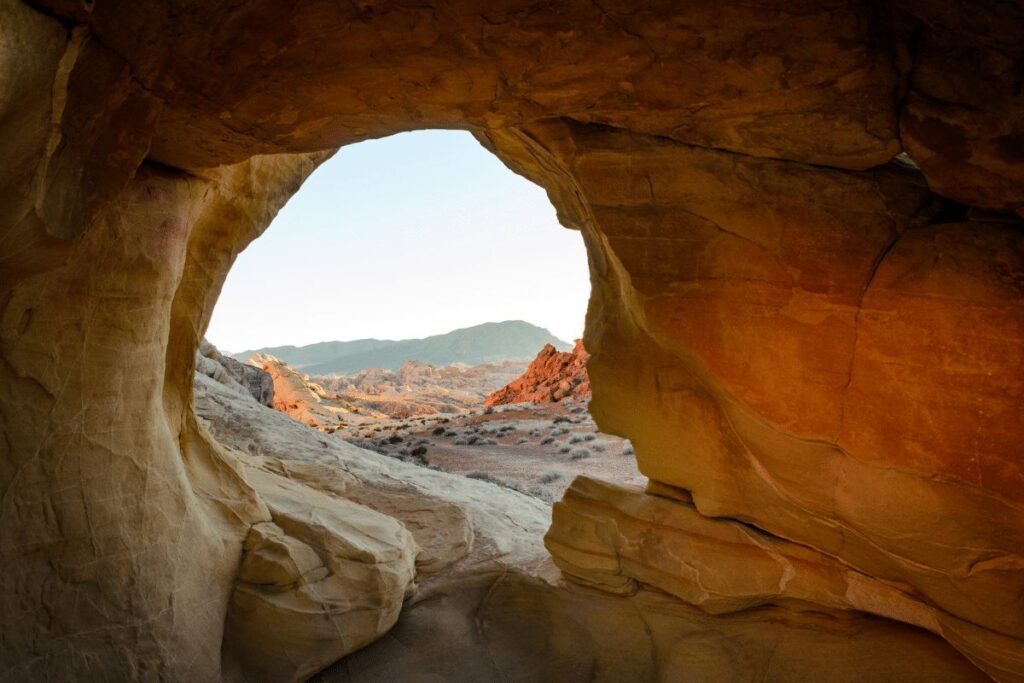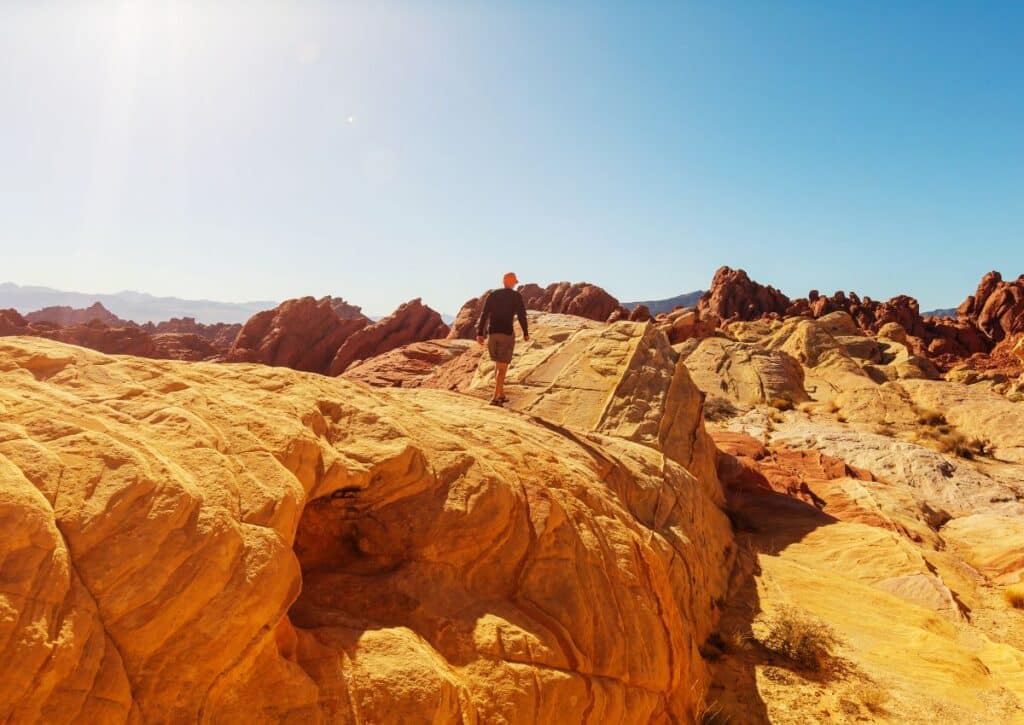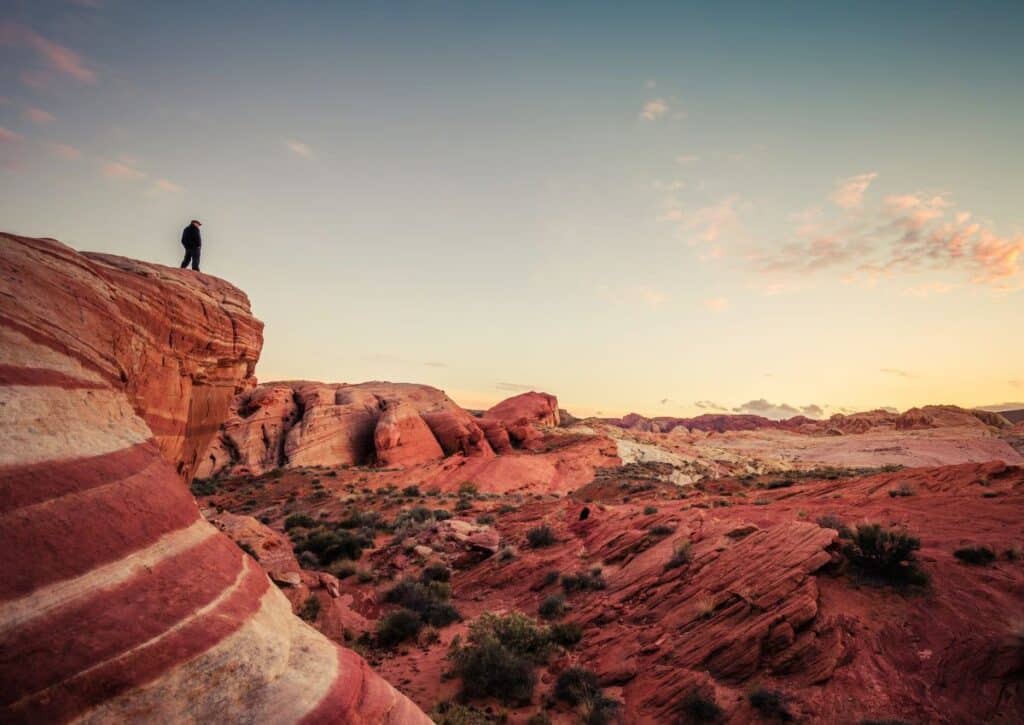Explore camping in Valley of Fire State Park with our guide, covering essentials, campgrounds, weather, costs, permits, wildlife, and more for a great trip!
Camping in Valley of Fire State Park allows you to unwind amid ancient petroglyphs and billion-year-old sandstone.
Our guide to these flaming red rocks comes from over 20 years of adventures here in Nevada’s hidden gem. We have distilled our experiences into tips for securing campsites, beating the heat, and understanding desert life.
Soak up the colorful canyon views in solitude at Arch Rock Campground or enjoy amenities like hot showers at Atlatl Rock Campground.
Discover our advice for keeping comfortable, along with key details on permits, fees, and etiquette. Blend our guidance with your curiosity and prepare for an unforgettable escape filled with natural delight in Valley of Fire State Park.
Essential Information on Camping in Valley of Fire State Park
While camping the Valley of Fire State Park, you’ll find yourself surrounded by stunning red sandstone formations that have been formed over millions of years.
The Atlatl Rock Campground and Arch Rock Campground are two fantastic spots for visitors to set up camp and explore the beautiful natural surroundings.
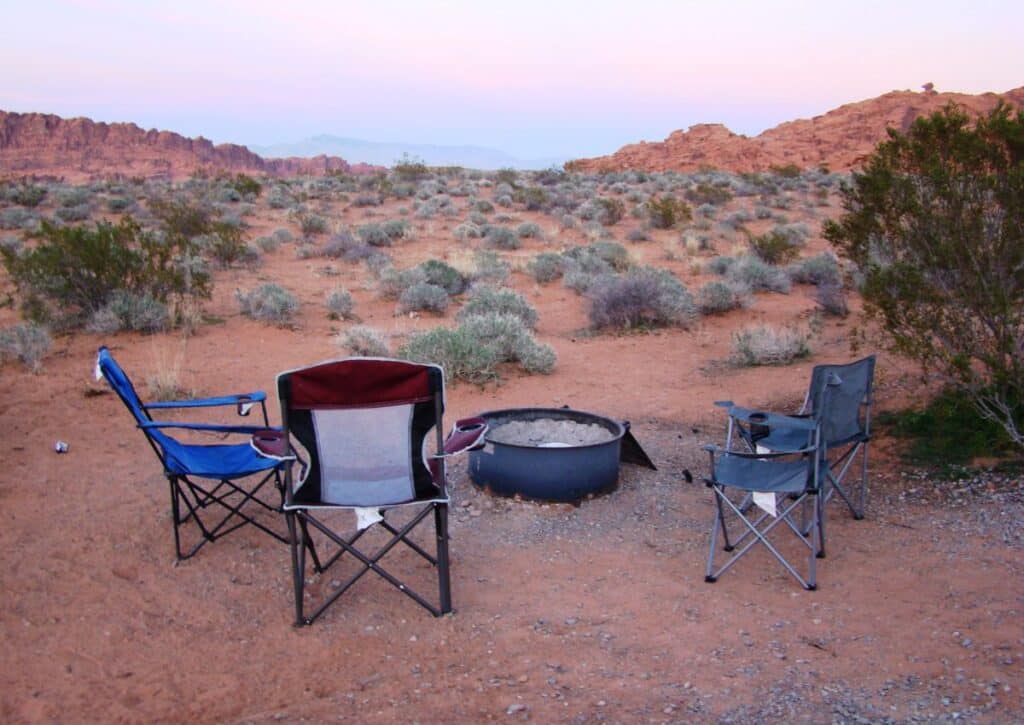
If you’re planning on camping here, it’s best to come in the spring or fall when the weather is cooler and more comfortable for outdoor activities.
Winters here can be chilly, with temperatures sometimes dropping below freezing, while summers can be incredibly hot, with daily highs frequently exceeding 100 degrees Fahrenheit.
However, with the stunning scenery all around you, you won’t be disappointed, no matter what time of year you choose to visit.
At the Atlatl Rock Campground, you’ll find a fantastic range of first-come, first-served campsites that are open all year round. The Arch Rock Campground is equally impressive, though it is only open when the park is busier.
Both campgrounds offer beautiful spots for stargazing, which is a must-do activity when you’re camping in Valley of Fire State Park. The dark sky is unspoiled by light pollution, giving you a stunning view of the starry sky above.
It’s essential to stake and tie down your tent correctly since the campgrounds can get quite windy at times, particularly at night. Once you’ve set up camp, make sure to explore all that the park has to offer. There are hiking trails, picnic areas, and plenty of opportunities to explore the beautiful rock formations that surround you.
The cost for a campsite here is just $20 per night, and this includes access to everything that the park has to offer. To get into the park, you’ll need to pay a $10 fee per vehicle, though Nevada residents can enjoy a reduced rate of $8. The good news is that this fee can be applied to your campground fee, so you’ll only need to pay an extra $10 when you arrive at the campsite.
If you’re traveling in an RV, you can opt for Atlatl Rock Campground, which offers water and electric hookups for an additional $10.
Camping in the Valley of Fire State Park is an unforgettable experience that you won’t want to miss. Lets go into both in more detail.
Atlatl Rock Campground
Atlatl Rock Campground is one of the two campgrounds located in the Valley of Fire State Park, Nevada. It is the main campground in the park and offers a great camping experience for visitors to the area.
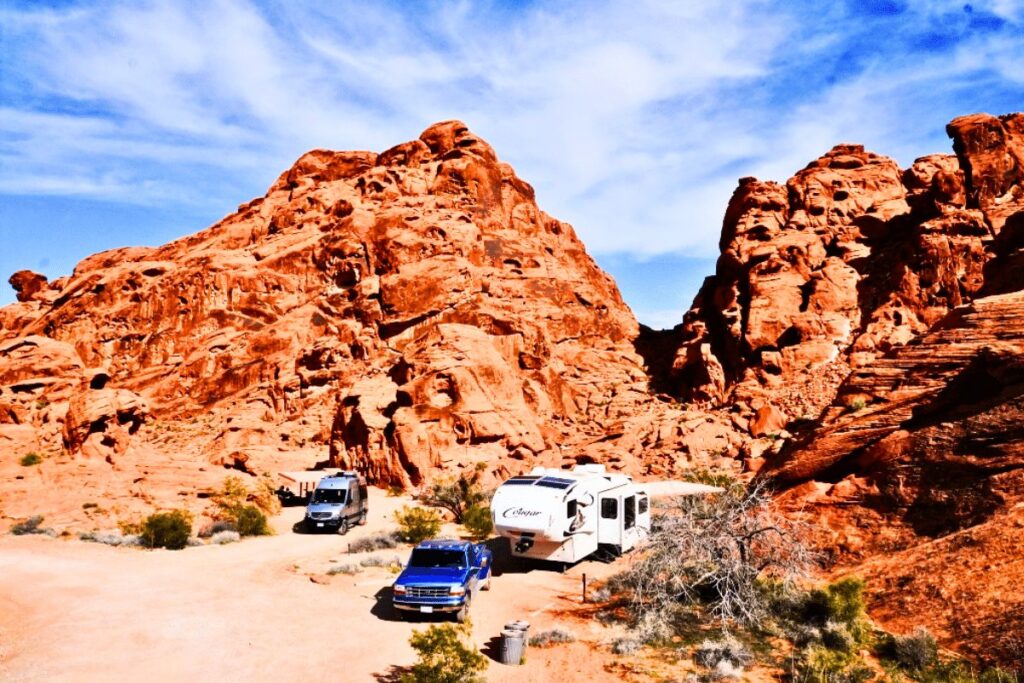
Below is a detailed guide on everything you need to know about Atlatl Rock Campground.
Location and Directions:
Atlatl Rock Campground is located on the west side of Valley of Fire State Park, adjacent to the famous Atlatl Rock, which features petroglyphs from the Anasazi tribe.
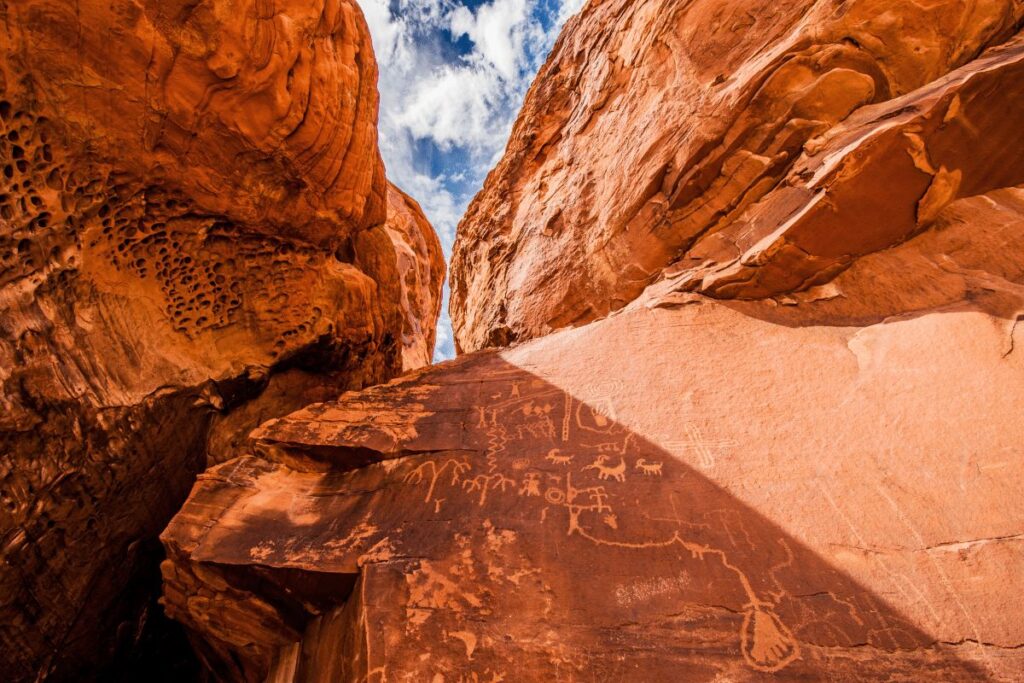
To reach the campground from Las Vegas, take Interstate 15 north for about 35 miles to exit 75, which has signs for Valley of Fire State Park and Lake Mead National Recreation Area.
After exiting, continue southeast on Valley of Fire Highway for 14.5 miles to reach the park’s west entrance. Drive another 1.8 miles and turn left onto Scenic Loop Road (Campground Road), which will be the first paved road on the left, directly across from a gravel road to Petrified Logs Loop.
After driving 0.3 miles to an intersection by a dump station, turn left on the road into Atlatl Rock Campground and reach the campground after another 0.3 miles.
For those coming from the east, from the intersection of Route 169 and 167 near Lake Mead, drive west on Valley of Fire Highway for two miles to the park’s east entrance. Drive another five miles through the park and turn right on Scenic Loop Road toward the campgrounds.
Campsites
Atlatl Rock Campground has 44 campsites, with each site numbered and spaced out from its neighbors. There are 19 standard sites with no hook-ups, including two that are handicap accessible, and three additional walk-in sites located at the back of the main loop.
A side loop has another 22 sites with water and electric hook-ups for RVs, with two of these sites being handicap friendly. Sites 23 through 44 are reserved for RVs only.
All campsites have a picnic table beneath a shade ramada, a fire ring, barbecue grill, and a flat spot to set up a tent. Water spigots are located next to each site to provide drinking water. The bathrooms have flush toilets and showers that don’t require coins and can be used at no additional charge.
General Information
Atlatl Rock Campground is open year-round, and campsites are first-come, first-serve, as the campground does not accept reservations.
The price for a campsite is $20 per night, and to enter the park, visitors pay a $10 fee per vehicle ($8 for Nevada residents), which can be applied toward the campground fee. RVs will stay at Atlatl Rock Campground on a loop with water and electric hook-ups that costs an additional $10.
Spring and fall are the ideal seasons to camp in the Valley of Fire State Park as temperatures are usually pleasant.
During winter months, temperatures can be below freezing, although snow is rare. In the summer, daily highs can exceed 100 degrees Fahrenheit and can get as hot as 120 degrees, making outdoor activities less enjoyable.
The campgrounds can get windy, especially at night, so it’s important to diligently stake and tie down your tent.
However, once the sun has gone down, the campgrounds offer great stargazing opportunities. With rocks that cut off light pollution from Las Vegas, you can stare up at the dark sky and see lots of stars.
Arch Rock Campground
While slightly smaller and more primitive than Atlatl Rock Campground, Arch Rock Campground is no less beautiful or enjoyable.
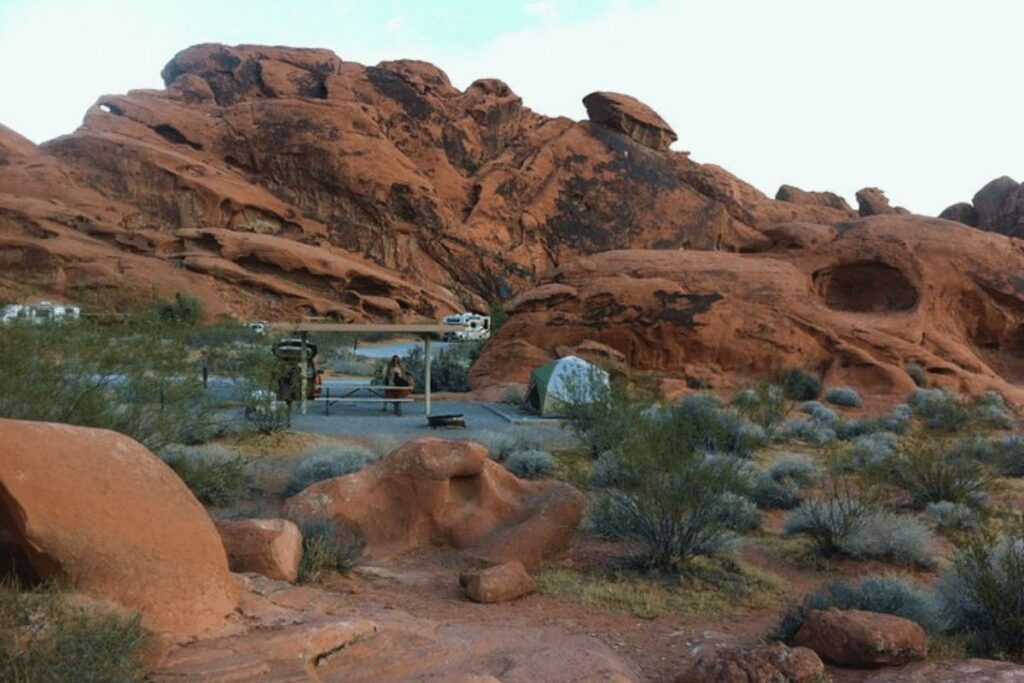
The campground is located close to Arch Rock, a natural sandstone arch, and offers visitors a chance to camp amidst stunning red sandstone formations.
How to Reach Arch Rock Campground
Arch Rock Campground is located in Valley of Fire State Park, Nevada, about an hour’s drive from Las Vegas. Visitors can reach the campground by taking Interstate 15 north for about 35 miles to exit 75 (signs for Valley of Fire State Park and Lake Mead National Recreation Area).
At the end of the offramp, go southeast on Valley of Fire Highway. Reach the park’s west entrance after 14.5 miles. Drive another 1.8 miles and turn left onto Scenic Loop Road (Campground Road). Drive 1 mile (passing Atlatl Rock Campground, Atlatl Rock, and Arch Rock. Just after Arch Rock, turn left into the campground.
Campground Details
Arch Rock Campground has 29 sites, with the first 14 sites centered around a loop, and the others spaced along a road that winds up through outcroppings of red sandstone to return to the road outside the campground.
Many of these sites offer privacy, and all come with picnic tables, shade ramadas, fire rings, barbecue grills, and potable water spigots. The campground has a mix of RV and tent sites.
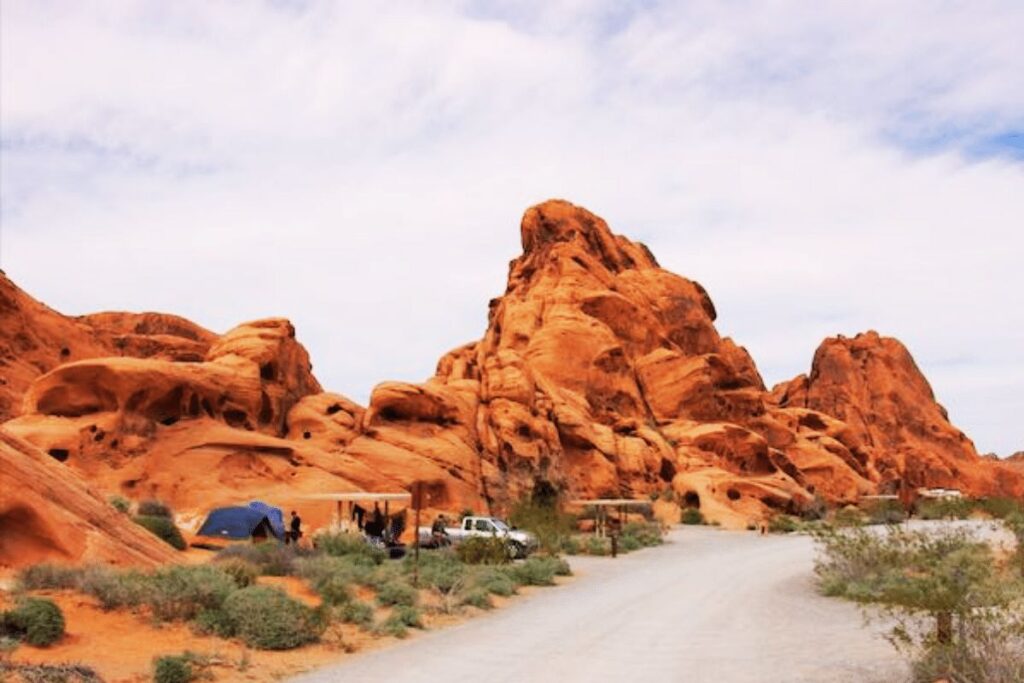
The biggest difference between Arch Rock and Atlatl Rock campgrounds is the bathroom facilities. Arch Rock Campground has vault toilet bathrooms and no showers, so visitors should be prepared accordingly. The campground may also be closed during slow seasons (winter and summer).
Trails
While there are no trails within the campground, visitors can explore the stunning red sandstone formations around Arch Rock and beyond. The natural sandstone arch of Arch Rock is just a short walk from the campground and is a popular spot for photos.
The campground is also close to other notable features within the park, such as Atlatl Rock and Mouse’s Tank Trail. Visitors can also explore trails throughout the park, such as the White Domes Trail, which takes hikers through a slot canyon and past towering sandstone formations.
Arch Rock Campground offers visitors a chance to camp amidst stunning red sandstone formations and explore the natural beauty of Valley of Fire State Park.
Valley of Fire Weather and Camping Considerations
The Valley of Fire, with its dramatic landscapes, also boasts a climate that can be as intense as its scenery. When planning a camping trip to the area, it’s essential to be aware of the weather conditions to ensure a safe and enjoyable experience.
- Temperature and Seasons:
- Spring and Fall: These are the most popular times for camping as the weather is relatively mild with daytime temperatures ranging from 70°F to 80°F. Nights can be cooler, so bringing layers is advisable.
- Summer: Daytime temperatures can soar above 100°F. It’s essential to stay hydrated, avoid strenuous activities during peak heat, and seek shade. Some campers prefer night-time excursions to avoid the heat.
- Winter: The weather is cooler with daytime temperatures ranging from 50°F to 60°F. However, night temperatures can drop significantly, so warm camping gear is a must.
- Precipitation: Rainfall is sporadic but can lead to flash floods. If camping during a period of potential rain, always set up camp away from dried river beds and low-lying areas.
- Wind: The region can experience strong winds. Ensure tents and other camping gear are securely anchored.
For up-to-date weather information and advisories, campers should check with local weather sources or the Valley of Fire Visitor Center.
Valley of Fire Visitor Center: A Camper’s Guide
The Valley of Fire Visitor Center is an invaluable resource for campers and visitors alike. Here’s what campers can expect:
- Information Desk: Staffed by knowledgeable park rangers, the information desk provides insights into the best camping spots, current weather conditions, and any park advisories.
- Exhibits: The center hosts a range of exhibits detailing the park’s history, geology, flora, and fauna. Campers can learn more about the area they are exploring and gain a deeper appreciation for its natural wonders.
- Campground Reservations: If you haven’t booked a spot in advance, the visitor center can provide information on campsite availability and help with reservations.
- Amenities: The center has restrooms, water refill stations, and a small shop where campers can purchase essentials, souvenirs, or grab a map of the park.
- Educational Programs: Throughout the year, the visitor center organizes ranger-led talks and programs that can enhance the camping experience. Topics range from stargazing to understanding the desert ecosystem.
For campers, a visit to the Valley of Fire Visitor Center can set the tone for an informed, safe, and enriching experience in the park. It’s a hub of information and a gateway to the breathtaking landscapes of the Valley of Fire.
Wildlife Encounters When Camping in Valley of Fire State Park
Camping in Valley of Fire State Park is a unique experience, not just because of its striking geology but also due to its rich biodiversity.
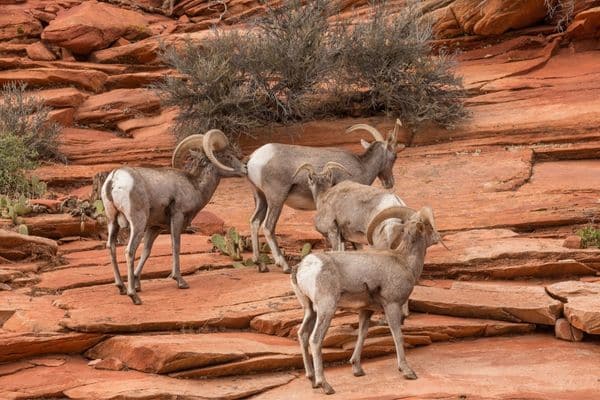
The desert environment teems with life, and campers are likely to encounter various creatures during their stay. Here’s what to expect and how to ensure a harmonious coexistence:
- Mammals:
- Bighorn Sheep: Often considered the park’s icons, these majestic animals can sometimes be spotted around campgrounds, especially during cooler parts of the day.
- Coyotes: While they usually keep their distance, it’s essential to store food securely to avoid attracting them to your campsite.
- Desert Kit Foxes: These nocturnal creatures might be seen during the early mornings or at dusk.
- Birds:
- Red-Tailed Hawks: Frequently seen soaring in the sky, they are a treat for birdwatchers.
- Costa’s Hummingbirds: Their iridescent feathers are a sight to behold as they flit between desert flowers.
- Gambel’s Quail: Recognizable by their topknots, they often scurry about in the underbrush.
- Reptiles:
- Chuckwallas: These large lizards often bask in the sun on rocks.
- Desert Tortoises: A protected species, seeing one is a rare and special experience. If you encounter them on trails, give them space and do not disturb.
- Speckled Rattlesnakes: While they prefer to keep to themselves, always be cautious when exploring and setting up camp.
- Insects and Arachnids:
- Tarantulas: These gentle giants might look intimidating, but they are usually harmless unless provoked.
- Scorpions: Always check shoes, clothes, and sleeping bags before use. Their stings can be painful, so caution is advised.
Safety Tips:
- Always store food in airtight containers or your vehicle to avoid attracting wildlife.
- Maintain a safe distance from all wild animals. They are best observed without interference.
- Do not feed wildlife. It can be harmful to them and alter their natural behaviors.
- Use a flashlight during nighttime walks. It can help spot creatures and avoid unwanted encounters.
- Be informed about the wildlife in the area. The Valley of Fire Visitor Center provides educational materials and can answer any questions.
Remember, the desert is a thriving ecosystem, and camping in the Valley of Fire offers an opportunity to immerse oneself in this unique environment. Respecting and understanding its inhabitants ensures a memorable and harmonious camping experience.
How much does it cost to camp in Valley of Fire State Park?
Camping in Valley of Fire State Park is not only a visual treat but also budget-friendly. The cost for setting up your camp here is $20 per night. If you’re bringing an RV and need water and electric hookups, the Atlatl Rock Campground provides these facilities for an additional $10. It’s essential to note that this fee grants you access to all that the park has to offer, making it a value-for-money experience for nature enthusiasts.
Can you disperse camp in Valley of Fire State Park?
Dispersed camping, or camping outside of designated camping areas, is not allowed in Valley of Fire State Park. The park is dedicated to preserving its natural beauty and habitat, which is why visitors are required to camp only in designated areas like the Atlatl Rock and Arch Rock Campgrounds. This ensures minimal impact on the environment and a safe experience for all visitors.
Do you need a permit for Valley of Fire State Park?
While you don’t need a specific permit to enter or camp in Valley of Fire State Park, there is an entrance fee, which acts similarly to a permit. It’s essential to keep your receipt as proof of payment and ensure that you follow all park rules and regulations during your stay.
Are reservations required for Valley of Fire State Park?
Reservations are not mandatory for Valley of Fire State Park, but they are highly recommended, especially during peak seasons when the campgrounds tend to fill up quickly. Both the Atlatl Rock and Arch Rock Campgrounds operate on a first-come, first-served basis, but making a reservation can guarantee a spot and provide peace of mind during your trip.
Is Valley of Fire worth it?
Absolutely! Valley of Fire State Park is a captivating destination, offering a unique blend of stunning geology, rich history, and diverse flora and fauna. The vibrant red sandstone formations, combined with numerous hiking trails and picturesque views, make it a must-visit for nature lovers and adventure seekers alike. Whether you’re camping, hiking, or just driving through, the park promises a memorable experience.
Is there an entrance fee to Valley of Fire?
Yes, there is an entrance fee to Valley of Fire State Park. The cost is $10 per vehicle, with Nevada residents enjoying a reduced rate of $8. The good news is that if you’re camping in the park, this fee can be applied to your campground fee, ensuring you get the best value for your visit. Always keep the receipt as it serves as proof of payment during your stay.
Conclusion
Camping in Valley of Fire State Park offers a one-of-a-kind experience, blending the allure of ancient geological wonders with modern amenities for campers.
Whether you’re nestled under the vast starry expanse at Arch Rock Campground or taking advantage of the RV facilities at Atlatl Rock Campground, this park promises a memorable stay.
Remember to factor in the seasonal weather variations, ensuring your trip is as comfortable as it is breathtaking. With its budget-friendly fees, unparalleled natural beauty, and ample opportunities for adventure, Valley of Fire State Park stands out as a premier camping destination.
Whether you’re a seasoned camper or a first-timer, the park’s splendors await your discovery. So, pack your gear, respect the environment, and let the timeless landscapes of Valley of Fire become the backdrop to your next unforgettable camping journey.

